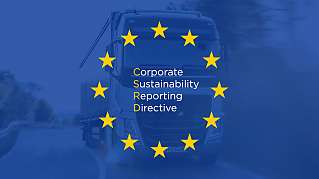







Are you required to disclose climate-related risks and opportunities?
Since April 2022, the Financial Conduct Authority (FCA) has requested all UK publicly listed companies (FTSE or AIM) to encourage market transparency by reporting on their direct and indirect climate impact through the TCFD framework. For companies that operate vehicles, this includes fleet CO2 output.


Corporate Sustainability Reporting Directive
The Corporate Sustainability Reporting Directive (CSRD) is a new EU regulation that came into play in January 2024. It requires certain companies to report on, amongst other things, the impact of their activities on people and the environment. Even if your business is not required to report its CO2 emissions, you may still be impacted by the directive’s demand for more transparency around carbon emissions.
The Webfleet CO2 Report has you covered
The Webfleet CO2 Report gives you an accurate overview of your fleet’s direct emissions and indirect emissions for electric vehicles, which are represented as CO2 equivalent emissions (CO2-e) for your fleet. Using a methodology that’s certified by TÜV Rheinland Energy & Environment1, it provides detailed information on how much CO2-e your vehicles produce. As well as helping you to report your fleet equivalent emissions for regulations such as the EU’s Corporate Sustainability Reporting Directive (CSRD), it gives you visibility over how, where and why your fleet is producing unnecessary CO2

Webfleet CO2 Report helps you:
Track the CO2-e produced by every vehicle in your fleet
And take action to reduce your emissions
Report accurately and easily
On your business’ CO2-e emissions and environmental impact
Trust a methodology certified TÜV Rheinland Energy & Environment1
For reliable and actionable insights
Calculate CO2-e with the distance- or fuel-based method
So, if fleet fuel data isn't available, the distance-based method will be used.
Separate different trip modes for CO2-e emissions
Based on business, commute and private trips.
Key features of Webfleet CO2 report for fleets
Real-time and historical insights
The certified Webfleet CO2 Report enables you to get actual insights into the CO2-e produced by your vehicles. You can see not only how much CO2-e your vehicles are emitting, but also why and where it is happening. With these real-time and historical insights, you can zero in on where the real opportunities are to cut your fleet’s emissions.


Accurate report data
With the Webfleet CO2 Report you can rest assured you’ll have all the data you need to report on your CO2- emissions – in your financial reports or to your customers that request it. It’s the CO2-e reporting tool from a telematics provider with a methodology certified by TÜV Rheinland Energy & Environment. So, whether you need this data to stay compliant, stay competitive or both, Webfleet has you covered.
The impact of driving behaviour
Driving behaviour like idling and harsh braking can directly lead to needless fuel consumption and CO2-e emissions. With data on CO2-e emissions in your Webfleet OptiDrive 360 reporting, you can see specifically where drivers are needlessly increasing your carbon footprint and coach them to adopt more sustainable and cost-effective driving styles.


Scope 2 emissions in CO2 reporting
Scope 2 emissions for EVs are based on the electricity consumed during charging, as detailed in the CO2 report. Charging losses may need to be considered separately, depending on reporting boundaries. If electricity is sourced from an on-site photovoltaic system, this should also be included for accurate emissions calculations.
Webfleet CO2 Report: Distance-based method
The Webfleet CO2 Report allows customers to create CO2 emissions reports even if actual fuel or energy data is not available. Reporting CO2 emissions using distance requires additional information from you, such as fuel type, average fuel or energy consumption and vehicle class. Webfleet provides default values, but verifying and adjusting settings is crucial to obtaining the most accurate results.


Report on Scope 1 and Scope 2 emissions for your fleet
Webfleet CO2 Report provides insights and separates Scope 1, the direct emissions from internal combustion vehicles, and Scope 2, the indirect emissions from purchased electricity from the grid consumed by your electric vehicles. Download monthly and annual reports in Excel and PDF.
What you need to know about reporting on CO2
What is the Corporate Sustainability Responsibility Directive (CSRD)?
0
What is the Corporate Sustainability Responsibility Directive (CSRD)?
0The Corporate Sustainability Reporting Directive (CSRD) is a new EU regulation that requires companies to report on risks and opportunities arising from social and environmental issues, such as climate change, and on the impact of their activities on people and the environment. While different types of businesses will be affected by the regulation at different times, over the coming years many thousands of companies across the continent will need to comply with it.
How are fleet CO2-e emissions calculated with Webfleet CO2 Report?
0
How are fleet CO2-e emissions calculated with Webfleet CO2 Report?
0There are two methods for accurately calculating fleet CO2-e emissions in line with the GHG Protocol standard. Firstly, there’s the fuel-based method, which takes the fuel consumed by a business’ vehicles and makes a calculation based on the appropriate emission factor of that fuel. This is one of the two methods of calculation possible with the Webfleet CO2 Report and is considered the best way to estimate CO2 emissions.
The second method is the distance-based calculation, which makes it possible to create CO2-e emissions reports when there is no fuel consumption data available. This feature allows the use of different devices capable of reporting basic telemetry data (position, distance). At the same time, distance-based reporting requires more calculation input:
- Fuel type
- Average fuel consumption
- Vehicle class (based on vehicle mass/size)
Webfleet provides default values for most common cases, but it is crucial to verify and adjust settings to obtain the most accurate results.
The distance-based reporting method provides estimated values. It is calculated using the current values of the parameters mentioned above. Any changes related to input information will affect the results of the generated CO2 reports (including historical ones).The only immutable value is the distance reported by the telematic device.
Why is CO2 tracking important?
0
Why is CO2 tracking important?
0Accurately tracking CO2 emissions is crucially important for any fleet of any size for many reasons. Most importantly, if you do not have visibility over the level of CO2 you produce you cannot take meaningful action to reduce your emissions or track the success of such actions over time. So, any attempt to run more sustainably or efficiently relies on this visibility.
As mentioned above, there is also the need to comply with regulations. More and more companies will have to provide accurate data on CO2 emissions over the coming years or risk penalties and potential loss of earnings.
So, for the planet, for business and for your company’s bottom line, tracking CO2 is no longer an optional activity but a must-do.
How can I use the CO2 Report for my fleet?
0
How can I use the CO2 Report for my fleet?
0The Webfleet CO2 Report gives you accurate information on the level of CO2 equivalent produced across your fleet. With this data you can fulfil your reporting responsibilities on things like CSRD, identify areas in your operation where you could take action to run more sustainably and measure the success of your initiatives to reduce your impact on the planet.
How to reduce your carbon footprint using fleet management software?
0
How to reduce your carbon footprint using fleet management software?
0Connecting your fleet with a fleet management solution like Webfleet is the first step to getting the kind of insights into your CO2 equivalent emissions you need to start reducing your impact on the environment. Improving driving behaviour, making the switch to EVs, reporting on CO2, detecting tyre underinflation, optimising your routes, keeping your vehicles as fuel efficient as possible – all of this and much more becomes possible with the power of Webfleet at your fingertips.
What are Scope 3 GHG emissions?
0
What are Scope 3 GHG emissions?
0Scope 3 GHG emissions are all indirect emissions that occur in the upstream and downstream value chain of the reporting company. Scope 3 emissions are typically the greatest component of a corporate or financial services company’s footprint. They are also difficult to measure and manage because they occur outside of an organisation’s operational control.
How could smaller organisations be affected by CSRD and Scope 3 emissions?
0
How could smaller organisations be affected by CSRD and Scope 3 emissions?
0Even if your business is not obliged to report on your own carbon footprint, you might be asked by your larger customers to provide information on the CO2 emission from your vehicles when providing goods or services to them. This is because they will need to report on those Scope 3 emissions to comply with CSRD. This may mean the ability to provide accurate data on your CO2 can become a competitive advantage for you in the coming years.
How can Webfleet help you to provide information on your carbon footprint?
0
How can Webfleet help you to provide information on your carbon footprint?
0The Webfleet CO2 Report gives you accurate information on the CO2 equivalent emissions produced by your connected vehicles. With this data, you can fulfil your CSRD reporting responsibilities or provide this data to your larger customers, so they can report on their Scope 3 emission.
What does CO2 equivalent (CO2-e) mean for companies?4
0
What does CO2 equivalent (CO2-e) mean for companies?4
0CO2-e is the universal unit of measurement to indicate the global warming potential (GWP) of greenhouse gasses, expressed in terms of the GWP of one unit of carbon dioxide. In accordance with relevant GHG protocol guidelines, companies are required to quantify and report on their emissions of the following greenhouse gases: carbon dioxide (CO2), methane (CH4), nitrous oxide (N2O), hydrofluorocarbons (HFCs), perfluorocarbons (PFCs) and sulfur hexafluoride (SF6). While it's not legally required, companies should consider reporting on nitrogen trifluoride NF3, especially if it's material to your operations. You are not required to provide individual figures for the emissions of each GHG listed, although it is an option. However, you must state in your report the annual quantity of GHG emissions in tons of carbon dioxide equivalent (CO2-e) that resulted from (for example) the combustion of fuel. Webfleet CO2 Report gives organisations accurate information on the level of CO2-e produced across their fleets, in compliance with the GHG protocol.






Your consent is required
In this section, external content is being embedded from .
To display the content, your consent is required for the following cookie categories:
- Targeted Advertising
- Analytics & Personalization
- Essential
For further details, please refer to our privacy policy. If you are interested in how ###vendor_name### processes your data, please visit their privacy policy.








